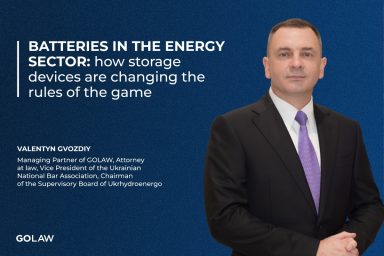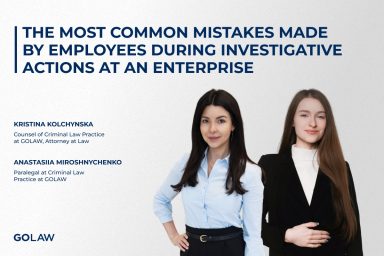Insolvency Litigation 2021: SPECIAL REPORT FOR LEXOLOGY
Contents
Commencing proceedings
Litigation climate
How would you describe the general climate surrounding insolvency litigation in your jurisdiction? What are the most common sources of dispute? To what extent is litigation used as a pressure or delay tactic?
Ukraine continues to reform its bankruptcy system, aiming to improve the business environment and make the country more attractive for investment.
As part of the reform, the Law on Restoring Debtor Solvency or Declaring a Debtor Bankrupt was amended by the Bankruptcy Code. Bankruptcy proceedings used to be tedious and time-consuming and parties acting in bad faith would often try to delay the process. Thus, to make bankruptcy proceedings more efficient, the Bankruptcy Code was adopted. The Code establishes mechanisms regarding the terms, rights and obligations of creditors, debtors, etc, which make it impossible to unreasonably delay the consideration of the case. In addition, the bankruptcy proceeding of a legal entity cannot be suspended, which undoubtedly affects the duration of the trial. The Code provides a limited list of court judgments that may be appealed in cassation. As these mechanisms have made proceedings more efficient, debtors acting in bad faith are generally deprived of the possibility to delay the process by filing unreasonable complaints.
As the Bankruptcy Code entered into force relatively recently (on 21 October 2019), litigation practice regarding a large number of norms in the Code is still being formed.
Sources of law
What key sources of law form the basis of claims arising from insolvency? How does the insolvency regime interact with other laws (eg, tort law and general corporate law)?
The Bankruptcy Code is the key act regulating bankruptcy proceedings. General procedural issues regarding insolvency are regulated by the Commercial Procedural Code.
Within the framework of bankruptcy cases, commercial courts are entitled to resolve any property disputes to which the debtor is a party and apply the relevant legislation regulating these legal relations, for example the Commercial Code and the Civil Code. In addition, courts can apply other sources such as relevant orders and resolutions of the Ministry of Justice and the Cabinet of Ministers.
The legislation on restoring a debtor’s solvency or declaring it bankrupt does not apply to banks that are withdrawn from the market or liquidated in accordance with the Law on Banks and Banking and the Law on Households Deposit Guarantee System. A mortgage bonds issuer can be declared insolvent (bankrupt) according to the Bankruptcy Code, taking into account the Law on Mortgage Bonds. A collective investment institution can be declared insolvent (bankrupt) according to the Bankruptcy Code, taking into account the Law on Collective Investment Institutions.
Proceedings in bankruptcy cases involving non-resident creditors are regulated by the Bankruptcy Code, unless otherwise provided for in international agreements.
Procedure
What procedural rules govern insolvency litigation in your jurisdiction? What common procedural hurdles arise in practice?
The special legislative act regulating bankruptcy proceedings in Ukraine is the Bankruptcy Code. Bankruptcy cases are considered by commercial courts according to the Commercial Procedural Code.
According to the legislation, the commercial court can refuse to accept an application for the opening of bankruptcy proceedings if:
- the debtor’s bankruptcy proceedings are not allowed under the Bankruptcy Code;
- the application is filed by a creditor whose requirements were included in the approved restructuring (sanation) plan and there is no evidence of non-fulfillment of these obligations;
- bankruptcy proceedings have already been opened against the debtor; or
- as a legal entity, the debtor is terminated in accordance with the procedure established by law.
If it is established that the application does not comply with the requirements of the Bankruptcy Code, the court will allow the applicant to correct the defects of the claim within a certain time frame.
If the applicant does not eliminate the defects of the claim within the time limit established by the court, the application is considered unfiled. The court will then return the application to the applicant.
In addition, the commercial court has a right to return an application for the opening of bankruptcy proceedings and any attached documents without consideration in certain cases defined by law. The return of the application does not prevent the applicant from reapplying to the commercial court in accordance with the established procedure.
Courts
Which courts hear insolvency claims? How experienced are they with insolvency litigation? (Are there any specialised insolvency courts?)
There are no specialised courts to hear insolvency claims in Ukraine. According to the Bankruptcy Code and the Commercial Procedural Code, bankruptcy cases are considered by commercial courts at the location of the debtor. Commercial courts have jurisdiction to consider all bankruptcy-related matters, including all monetary claims against the debtor.
The only exception is criminal cases related to bankruptcy matters. The courts of general jurisdiction specifically consider matters on seizure of property, such as cases against ultimate beneficial owners and chief executive officers of the debtor (if a legal entity) for intentional actions that have led to the financial insolvency of the business and caused great damage.
Commercial courts have existed for more than 30 years in Ukraine and in this time a large scope of judicial practice was formed related to bankruptcy. Legislation is also constantly changing, which has a significant impact on judicial practice. This has resulted in a large number of professional specialists in the field of bankruptcy.
Jurisdiction
Through what law (statute, common law, etc) do the relevant courts have jurisdiction to hear insolvency claims? Does jurisdiction differ for domestic and cross-border matters?
The Bankruptcy Code and the Commercial Procedural Code entitle commercial courts to consider bankruptcy cases.
Bankruptcy proceedings involving non-resident creditors are regulated by the Bankruptcy Code, unless otherwise provided by international agreements.
As for cases with a foreign element, the jurisdiction of the courts of Ukraine is exclusive if the debtor in the bankruptcy case is a company that was established in accordance with the legislation of Ukraine.
Limitation periods
What limitation periods apply to bringing insolvency-related claims? Are there any notable exceptions?
Limitation periods for bringing insolvency-related claims are determined in the Civil Code. Generally, a party must file a claim within three years. If the claim is not brought within this period, there is a risk that that it will be considered time-barred.
In addition, there are specific limitation periods stipulated by the Civil Code for certain types of claims, such as reduced and extended periods. For example, a one-year limitation period applies to claims for the award of penalties and fines. The parties to a dispute may not agree to suspend time limits. Ukrainian legislation allows the parties to a contract to extend the limitation period established by law, but it is not possible to reduce it.
Interim remedies
What interim remedies are generally available and commonly deployed in insolvency proceedings? How are these used as part of claimants’ overall litigation strategy?
The Bankruptcy Code is somewhat pro-creditor and includes rules aimed primarily at protecting the rights of creditors and improving the credit climate in Ukraine.
Commercial courts have the right to decide whether to grant interim remedies for creditors’ claims at the stage of receiving an application to open bankruptcy proceedings. The court can prohibit the owner of the debtor’s property (a body authorised to manage the debtor’s property) and the debtor from making decisions on liquidation and reorganisation of the debtor, and alienate fixed assets.
In the case of filing an insolvency-related claim, commercial courts have the right to grant the following interim remedies:
- attachment of the respondent’s assets;
- prohibition on taking certain actions;
- establishment of an obligation to take certain actions;
- suspension of the sale of property, if a claim is filed on the recognition of ownership of this property, or its exclusion from the description and its release from attachment; and
- other measures provided by law and international agreements.
When submitting an application to the court for interim remedies, the applicant must substantiate the reasons for applying for the remedies and provide the court with evidence of the actual circumstances relating to the remedies.
Evidence
What rules and procedures govern the collection and admissibility of evidence in insolvency litigation? To what extent is expert witness testimony allowed? What common evidential issues should claimants be aware of?
When filing an application to open bankruptcy proceedings, the creditor or debtor has the right to submit relevant evidence to the court. The procedure for submitting evidence and the requirements for its adequacy, admissibility, reliability and probability are determined by the Commercial Procedural Code.
The parties in the case have the right to substantiate their claims with an expert’s opinion. An expert may be appointed by a court or be invited by a party in the case. The expert is obliged to provide a reasonable and objective written opinion on the questions posed to him or her. Experts rarely give oral evidence at trial; however, they can be called to the court to clarify their expert opinion and answer the participants’ questions.
The parties must submit evidence together with the first application in the case.
The claimants should be aware that if evidence cannot be submitted for objective reasons, the party must notify the court in writing and must:
- explain that the evidence that cannot be submitted;
- give reasons why the evidence cannot be submitted within a specified period of time; and
- provide evidence confirming that it has carried out all the actions required of it to obtain the specified evidence.
Evidence not submitted within the term established by the law or the court will not be accepted for consideration by the court.
Time frame
What is the typical time frame for insolvency claims (from any pre-action protocols to final judgment)?
There are no specific time frames for consideration of insolvency claims. Such cases can be considered for years.
However, the Bankruptcy Code establishes some procedural time limits, for example: five days to accept an insolvency application from its receipt by the court; 20 days’ maximum to conduct a preparatory hearing from acceptance of an insolvency application; and three months’ maximum to hold a preliminary hearing from the date of a preparatory hearing.
The Bankruptcy Code also sets the terms for some stages of the bankruptcy proceedings. Thus, the asset management procedure must not last for more than 170 days and the liquidation of the debtor shall not exceed 12 months. The Bankruptcy Code does not restrict the time for the financial rehabilitation (sanation) of the debtor.
In Ukraine, there is a principle of reasonableness of the terms of consideration of the case by the court. One of the goals of the bankruptcy reform is to make the consideration of such cases more efficient and prevent any unreasonable delay.
Appeals
What are the requirements to appeal insolvency-related judgments? What is the typical time frame for appeals?
The right to appeal is prescribed by the Constitution of Ukraine. The decision to declare the debtor bankrupt and open the liquidation procedure or the procedure to repay debts, and the decisions of the local commercial court adopted in a bankruptcy case (except the cases stipulated by the Commercial Procedural Code and the Code on Bankruptcy Procedures) may be appealed.
The Commercial Procedural Code defines a list of court rulings that can be appealed separately from the decision of the court of first instance – for example, a ruling on interim remedies, a refusal to open proceedings in a case, the appointment of experts and the suspension of proceedings in a case.
The grounds for appeal can be varied and differ for each particular case. The appellant must mention in its appeal why the decision of the local court is unlawful or unsubstantiated. Usually, the most common reasons stated by appellants are the following:
- violation of procedural law;
- incorrect enforcement of material law;
- failure to establish the facts of the case; and
- incorrect establishment of the facts of the case.
Ukrainian procedural legislation establishes a 20-day term for submitting an appeal against a decision from the date of the decision and a 10-day term for appealing a ruling from the date of promulgation. In the case of an admissible excuse, these terms can be renewed.
Costs and litigation funding
How are costs handled and how are claims funded? Can claimants obtain third-party funding to finance the prosecution of claims?
The amounts of the court fees in bankruptcy cases are established by the Law on Court Fees.
The parties can ask the court to recover the court costs that they have incurred in connection with the case. Based on the outcome of the case, the court has the power to distribute court costs between the parties in accordance with the rules set out in the Commercial Procedural Code. The costs are assessed on the basis of the evidence submitted by the parties and in accordance with the established rules of law.
Generally, the payment of court fees and other court costs is ordered against the losing party in the case.
The court may oblige the parties to deposit into the court’s deposit account a predetermined amount of court costs related to the proceedings or a certain procedural action.
Obtaining third-party funding to finance the prosecution of claims is not prohibited according to Ukrainian legislation. The Grand Chamber of the Supreme Court held in its judgment of 30 September 2020 in case No. 9901/144/20 that specifying a person other than the claimant as a payer in the payment document cannot be a ground for rejecting the document.
Avoidance actions
What are the essential elements of avoidance actions seeking to claw back fraudulent conveyances and transfers? Can actions be brought for transfers without fraudulent intent based on undervalue of the transfer? (If so, how do these actions differ?)
Transactions made by the debtor can be declared invalid by the commercial court in the bankruptcy proceedings. This applies to transactions carried out by the debtor after the opening of bankruptcy proceedings or in the three years before proceedings opened. The application to declare a transaction invalid can be filed by either the creditor or the receiver. If the court establishes the undervalue of a transaction, it may declare the transaction invalid.
Preference and improvement of position
What are the essential elements of avoidance actions seeking to claw back transactions and payments based on preference and improvement of position shortly before insolvency proceedings?
The Bankruptcy Code does not allow a bankruptcy receiver to claw back transactions and payments based on preference and improvement of position shortly before insolvency proceedings. At the same time, the Bankruptcy Code establishes that a bankruptcy receiver and a creditor may appeal transactions that were carried out by the debtor after the bankruptcy proceedings have been opened or during the three years before proceedings opened to the commercial court.
Liens and floating charges
What are the essential elements of actions for the avoidance of liens (eg, for perfection defects) and floating charges on subsequently acquired property?
Disputes concerning liens and floating charges to which a debtor is party are considered by the commercial courts according to the rules stipulated by the Commercial Procedural Code, taking into account any particularities set out in the Bankruptcy Code.
A creditor may appeal transactions that were carried out by the debtor after the bankruptcy proceedings have been opened or during the three years before proceedings opened.
Process and resolution of avoidance actions
Through what process are avoidance actions litigated? What procedural issues often arise and how are avoidance actions usually resolved?
All disputes to which a debtor is party are considered by the commercial courts according to the rules stipulated by the Commercial Procedural Code, taking into account any particularities set out in the Bankruptcy Code.
In bankruptcy cases, the commercial courts deal with disputes relating to:
- property (where the debtor is a party);
- claims against the debtor and its property;
- invalidation of auction results;
- invalidation of any agreements concluded by the debtor;
- the vindication of the debtor’s property or reimbursement of its value; and
- other requirements for the debtor.
Any materials relating to the debtor’s property disputes and proceedings opened prior to the bankruptcy proceedings must be sent to the commercial court, which considers the dispute within the framework of the bankruptcy case.
Claims against directors, officers and shareholders
Breach of fiduciary duty
What are the essential elements of a claim for breach of fiduciary duty against directors and officers in the context of corporate insolvency?
The directors and officers of the debtors bear subsidiary liability as well as joint and several liability in bankruptcy proceedings.
The Bankruptcy Code allows creditors to ask the court to impose joint and several liability on the debtor’s management. The legislation does not state which types of creditors (competitive, post-bankruptcy or secured) have the right to apply for joint and several liability to be imposed.
The application for such liability to be imposed can be made at any stage of the bankruptcy proceedings, but it must not be before the end of the preliminary hearing. The essential element of such an application is that the debtor’s director has failed to initiate the bankruptcy case in a timely manner. This fact shall be established in the court’s ruling on the commencement of the bankruptcy proceedings.
The Bankruptcy Code does not establish any specific application form for the assignment of subsidiary liability. However, subsidiary liability can be imposed at the stage of the debtor’s liquidation and only at the request of the liquidator. The essential element of such an application is the fact of driving the debtor into bankruptcy.
Protection from liability
To what extent does the law in your jurisdiction protect directors and officers from liability for decisions made in connection with the restructuring or insolvency (eg, the ‘business judgment rule’, rejection of ‘deepening insolvency’ theories, etc)?
Although Ukrainian legislation allows directors and officers to be held responsible for decisions made in connection with a restructuring or insolvency, the relevant case law on this issue is still being formed.
The Bankruptcy Code recognises joint and several liability and subsidiary liability. The Code establishes the following as prerequisites to impose liability: (1) the fact of the debtor’s director’s failure to initiate the bankruptcy case in a timely manner; and (2) the fact of driving the debtor into bankruptcy.
Therefore, Ukrainian insolvency legislation protects directors and officers from liability by having the obligation to prove points (1) and (2).
Converting credit to equity
Can credit extended by an insider or shareholder be recharacterised as equity? If so, what is the mechanism by which such an action is brought, and what elements are required to prevail?
The Commercial Code does not prohibit a shareholder’s credit from being characterised as equity.
The Bankruptcy Code states that the charter capital (equity) can be increased to restore the debtor’s solvency at the stage of financial rehabilitation (sanation) of the debtor according to the restructuring plan. The restructuring plan is approved by the creditors’ meeting prior to the end of the asset management procedure and is subsequently adopted by the court.
Illegal dividends
Can dividends received by shareholders be prosecuted as illegal?
According to the Bankruptcy Code, the debtor’s management does not have the right to decide on payment of dividends during the asset management procedure.
According to the provisions of the Law on Commercial Entities, the Law on Stock Companies and the Law on Limited Liability and Additional Liability Companies, the members of the general meeting of the commercial entity are entitled to decide on profits distribution. However, the courts usually conclude that the dividends payments of a company can take place only if the company receives net profit. Failing that, the dividends payments in bankruptcy proceedings contravene the purposes of the Bankruptcy Code. Therefore, the dividends received by shareholders can be prosecuted as illegal.
Trading while insolvent
How is trading while insolvent treated in your jurisdiction? If actionable, what mechanisms apply and what are the elements of a successful claim?
When insolvent, it is possible to conduct trading during the asset management procedure of insolvency. However, any trading decisions are subject to the consent of the creditors’ meeting. Generally, the receiver cannot interfere with the operational and economic activities of the debtor.
However, the receiver is entitled to file a claim with a commercial court to declare transactions invalid, including those concluded by the debtor in violation of the procedure established by the Bankruptcy Code.
Equitable subordination
Is equitable subordination of shareholder claims allowed? If so, what requirements and mechanisms apply?
Equitable subordination is a common-law doctrine. As the Ukrainian legal system is based on continental law, equitable subordination is prohibited.
Other claims
Are any other claims commonly brought against shareholders, directors and officers in your jurisdiction? If so, what mechanisms are used to raise these claims and what elements are required to prevail?
The creditors can ask the court to impose joint and several liability on the debtor’s management. The essential element of such application is that the debtor’s director has failed to initiate the bankruptcy case in a timely manner. This fact must be established in the court’s ruling on the commencement of the bankruptcy proceedings.
The liquidator is entitled to file claims against third parties that bear subsidiary liability for the debtor’s obligations in connection with driving the debtor into bankruptcy.
Risk mitigation
How can shareholders and sponsors mitigate the risk that claims against them will be successful, and minimise the accompanying financial burden (eg, through internal investigations, mediation, early settlement, etc)?
To protect themselves in bankruptcy proceedings, shareholders, sponsors and the management of an insolvent debtor should adopt a proactive attitude when the claims against them are considered. It is the burden of shareholders and sponsors to prove their own innocence regarding actions and events that caused permanent insolvency. In proving one’s innocence, it is advisable to involve an expert on finance and economic issues to show the court that the actions being considered did not cause insolvency.
Creditor actions and strategic considerations
Contesting restructuring plans
Can creditors bring actions contesting the restructuring plan? If so, what law governs such actions? What must the creditor show to succeed and what must the debtor show to successfully defend? How are these actions usually resolved?
According to the Bankruptcy Code, the restructuring plan is approved by the creditors’ meeting prior to the end of the asset management procedure. The court then adopts the restructuring plan in its ruling. There are no restrictions on creditors contesting this ruling. To succeed in such a claim, the creditor must show the court of appeal that the restructuring plan was adopted in breach of the law.
Winding-up petitions
Do creditors apply for winding-up orders? If so, what law governs these actions? What must the creditor show to succeed and what must the debtor show to successfully defend? How are these actions usually resolved?
According to Ukrainian insolvency litigation, if the court recognises debtor as bankrupt than the liquidation procedure begins.
Given the provisions of the Bankruptcy Code, the creditors decide on the liquidation of the debtor in the creditors’ meeting. The creditors can apply for the debtor liquidation by submitting their decision to the court. The court allows such a petition only if there are indications of the debtor’s bankruptcy.
The creditor must persuade the court that the debtor’s situation is irredeemable – namely, that there is a lack of property to satisfy the creditors’ claims. In contrast, the debtor must show the court that sufficient property exists or that financial rehabilitation would be advisable (or both).
The court finishes the liquidation and closes the bankruptcy proceedings when a bankrupt (legal entity) is terminated in the manner prescribed by law.
Does the insolvency regime stay any creditor collection actions? If so, what are the parameters of such a stay? Are there any notable or commonly used exceptions?
The Bankruptcy Code provides a moratorium on satisfaction of creditors’ claims. Thus, the debtor is obliged to stop fulfilling its monetary liability and liability on payment of taxes and fees (obligatory payments), the term of which will have preceded the date of the moratorium. The debtor must also terminate any measures aimed at fulfilling the above-mentioned liability.
A moratorium on satisfaction of creditors’ claims is introduced simultaneously with the opening of bankruptcy proceedings. The decision on the moratorium withholds enforcement actions.
Generally, during the moratorium on satisfaction of creditors’ claims:
- it is prohibited to conduct recovery on the basis of enforcement and other documents containing property claims, including collateral;
- it is prohibited to comply with the claims covered by the moratorium;
- no penalty (fine) is charged and no other financial sanctions are applied for non-fulfilment or improper fulfilment of obligations on satisfaction of all claims covered by the moratorium;
- the limitation period is suspended; and
- the inflation index, the 3 per cent penalty and other fines are not applicable for the entire period of overdue performance of the monetary obligation, etc.
The moratorium shall be terminated on the date the bankruptcy proceedings are closed.
Stays of proceedings – strategy
How do creditors navigate stays in practice? How do stays generally affect their litigation strategy?
Generally, the moratorium is terminated when the bankruptcy proceedings are closed. However, there is an exception when creditors can navigate moratoria in practice. Thus, the secured creditor at the financial rehabilitation stage can ask the court to terminate the moratorium on the debtor’s property, the subject of the security, if the property is not involved in the debtor’s reorganisation plan or is perishable.
The moratorium is an obligatory step in all bankruptcy cases. All creditors and their lawyers know that the court will impose a moratorium, therefore all litigation strategies take this into account.
Stays of proceedings – effect on emergence from insolvency
How do stays affect the debtor’s emergence from insolvency?
The moratorium on satisfaction of creditors’ claims allows the debtor to:
- terminate the fulfilment of creditors’ claims;
- terminate recovery on the basis of enforcement documents;
- avoid payment of financial sanctions (penalties, fines); and
- avoid charges of the inflation index, etc.
This allows the debtor and the receiver to accumulate funds and reinstate their financial situation and recover from insolvency more quickly.
Are the courts in your jurisdiction empowered to punish creditors’ bad acts or inequitable conduct by pushing their claims down the priority waterfall? Can they void the claims altogether?
The courts do not have the power to punish creditors’ bad acts or inequitable conduct by pushing their claims down the priority waterfall. Courts cannot void the claims altogether based on bad-faith conduct.
Vote designation
Can creditors be disenfranchised based on bad-faith conduct?
Ukrainian law does not provide for the possibility to disenfranchise creditors due to their bad-faith conduct.
Pre-insolvency debtor claims
Available claims
To what extent can claims existing before insolvency be pursued against shareholders and their affiliates and agents during an insolvency proceeding – including any contractual, tort and misfeasance claims and claims for the recovery of company property? (What elements are required to succeed in these claims?)
The Bankruptcy Code envisages that all property disputes with claims against the debtor and its property, the proceedings of which started prior to the bankruptcy proceedings, shall be considered by the commercial court that deals with the bankruptcy proceedings. The court will consider the dispute on the merits within the framework of the bankruptcy case. Such claims cannot be directed against shareholders and their affiliates and agents during an insolvency proceeding.
The shareholders and management of the debtor bear subsidiary liability as well as joint and several liability within the bankruptcy proceedings if the debtor’s director failed to initiate the bankruptcy case in a timely manner and drove the debtor to bankruptcy.
The Bankruptcy Code defines several types of creditors in bankruptcy proceedings. Among these are competitive creditors who are involved with claims against the debtor that arose before the opening of bankruptcy proceedings, the implementation of which is not secured by the pledge of the debtor’s property.
Procedure and resolution
What procedural mechanisms and issues should be considered when bringing pre-existing claims? How are they usually resolved?
Competitive creditors are required to submit to the commercial court written applications with their claims and annexes thereto against the debtor within 30 days of the date of official publication of the opening of bankruptcy proceedings. If the creditor misses the 30-day deadline, it still has the right to file an appropriate application with claims. In fact, the same regime is provided for creditors as those who filed their claims within the prescribed period, except for the right to a casting vote at the meeting and the creditors’ committee.
Information on creditors that applied to the court shall be entered into the register of creditors’ claims.
Standing and assignment of claims
Who controls the pursuit of pre-insolvency debtor claims (eg, the debtor, or the trustee, examiner or similar appointee)? Can creditors or other stakeholders pursue them derivatively if the debtor or trustee refuses to do so?
Generally, debtor claims that arose before the insolvency proceedings will be considered by the court within the framework of the bankruptcy proceedings.
The receiver is the person responsible for preserving the debtor’s property and is obliged to take measures for such preservation.
Risk mitigation for creditors
How can creditors mitigate the risk that pre-insolvency debtor claims and remedies will be successful?
The Bankruptcy Code is primarily aimed at satisfying creditors’ claims. The Code provides for the following mechanisms to mitigate the risk that pre-insolvent debtor claims and remedies will be successful:
- transactions committed by the debtor after the opening of bankruptcy proceedings or during the three years prior to opening bankruptcy proceedings may be declared invalid by a commercial court at the request of the receiver or creditor, if they have filed losses to the debtor or creditors;
- the creditor can influence the debtor’s decision by participating in the creditors’ meeting or committee; and
- the creditors can request the court to take measures to secure their claims.
Minimising costs for creditors
How can creditors reduce the costs of litigation associated with these claims? What procedures are commonly used (eg, internal investigations, mediation and early settlement)?
The costs of litigation mainly comprise court fees, which are paid when the claim (or appeal) is submitted to the court, and receiver’s services. It is rare for parties to bear other additional charges in the case. Such payments are obligatory and cannot be reduced by creditors.
Mediation is not used in bankruptcy, as the bankruptcy procedure is clearly defined by the law.
Other claims
Other claims against creditors
Are there any other major categories of claims (not previously covered) that may be pursued against creditors during insolvency proceedings in your jurisdiction? If so, what are the essential elements of such claims?
No, there are not.
Other claims against debtors
Are there any other major categories of claims (not previously covered) that may be pursued against debtors during insolvency proceedings in your jurisdiction? If so, what are the essential elements of such claims?
No, there are not.
Cross-border proceedings
Parallel proceedings and international judgments
Are parallel proceedings and international judgments recognised in your jurisdiction? What are the requirements for recognition? Can recognition be challenged? On what grounds?
The recognition of international judgments is governed by section VIII of the Bankruptcy Code (Proceedings in bankruptcy cases related to foreign bankruptcy proceedings). International judgments can be recognised in Ukraine under the following conditions.
The foreign bankruptcy procedure and the international receiver must be officially recognised in accordance with Ukrainian law. Generally, the Bankruptcy Code provides for this recognition; however, no case law exists in which the Ukrainian court has granted such recognition.
At the same time, the Bankruptcy Code establishes the following requirements for recognition:
- the appropriate application for recognition shall be submitted to the commercial court by the foreign receiver;
- the application shall be submitted to the Ukrainian court before the adoption of the restructuring plan or liquidation in the framework of Ukrainian bankruptcy proceedings;
- the application and annexes to it are made in the official language of the country where the foreign bankruptcy proceeding is held; and
- the appropriate translation into Ukrainian language shall be submitted thereto.
The ruling regarding the recognition can be challenged on general grounds established by the Commercial Procedural Code. The appellant must mention in his or her appeal why the decision of the local court is unlawful or unsubstantiated. Usually, the most common reasons stated by the appellants are the following:
- violation of procedural law;
- incorrect enforcement of material law;
- failure to establish the facts of the case; and
- incorrect establishment of the facts of the case.
The Supreme Court can further review the decisions of the previous courts. However, the Commercial Procedural Code limits the circumstances for cassation appeals.
Judicial cooperation
To what extent if any will there be judicial cooperation with other courts in relation to insolvency proceedings?
Judicial cooperation with foreign courts and receivers in foreign bankruptcy proceedings is possible in certain cases. Such cooperation may take place as part of the bankruptcy proceedings, which are principal or derivative regarding the foreign bankruptcy proceedings. For example, a bankruptcy proceeding of the debtor, which is established and operates in accordance with the legislation of Ukraine and is located in the territory of Ukraine, is the principal proceeding against any other foreign proceeding; a bankruptcy proceeding of the debtor where the debtor is a permanent representation of a Ukrainian business entity in a foreign state is a derivative foreign proceeding to the principal proceeding in Ukraine. The cooperation with foreign courts and receivers is carried out by:
- committing actions in a foreign state;
- transferring information to a foreign court or foreign receiver, if the transfer is not prohibited by law;
- coordinating actions for asset management and economic activity of the debtor; and
- coordinating actions to provide judicial assistance during bankruptcy proceedings against the same debtor.
If the above-mentioned actions may harm the interests of the creditors or the debtor in proceedings under the Bankruptcy Code, the Ukrainian court may, on its own initiative or at the request of either party, suspend or prohibit appropriate actions.
Remedies and enforcement
Remedies for debtors
What legal remedies are broadly available to successful debtor-claimants (eg, damages, injunctive relief, specific performance, declaratory relief)? Have the courts awarded any notable remedies recently?
Usually, the initiator and claimant in bankruptcy proceedings is the creditor. However, the debtor can also initiate bankruptcy proceedings. The Bankruptcy Code does not provide for any specific legal remedies for debtor-claimants. However, it establishes that the commercial court in the bankruptcy case can decide on all property disputes to which the debtor is a party and disputes relating to the following:
- claims against the debtor and its property;
- invalidation of auction results;
- invalidation of any agreements concluded by the debtor;
- vindication of the debtor’s property or reimbursement of its value;
- wage recovery; and
- reinstatement of the debtor’s officials.
Remedies for creditors
What legal remedies are available to successful creditor-claimants (eg, damages, injunctive relief, specific performance, declaratory relief)? Have the courts awarded any notable remedies recently?
The Bankruptcy Code does not provide for any specific legal remedies for creditor-claimants. However, it establishes that the commercial court in the bankruptcy case can decide on all property disputes to which the debtor is a party and disputes relating to the following:
- claims against the debtor and its property;
- invalidation of auction results;
- invalidation of any agreements concluded by the debtor;
- vindication of the debtor’s property or reimbursement of its value;
- wage recovery; and
- reinstatement of the debtor’s officials.
Court enforcement mechanisms
What tools are available to the court to enforce its rulings? Are there any jurisdictional limits to the court’s enforcement powers?
Having received a court ruling, the parties in the case must independently apply to the executive service or a private executor to implement the decision. However, there are some cases when a court will use a mechanism to enforce its ruling. For instance, in declaring a debtor bankrupt and introducing a procedure for repaying the debts, the commercial court shall appoint a manager for the sale of the debtor’s property. Thereafter, the manager is responsible for enforcing the ruling regarding the repayment of the debtor’s debts.
According to the provisions of the Commercial Procedural Code, the parties to enforcement proceedings have the right to apply to the court if they feel that the decision, action or inaction of the bailiff during the execution of a court decision violates their rights. Upon consideration of such application, the court can oblige the bailiff to eliminate the violation (to restore the violated right of the applicant).
The current Code does not provide for limits on the court’s enforcement powers.
Settlement and mediation
General court approach
Are the courts in your jurisdiction generally amenable to settlements?
The Bankruptcy Code is silent on amicable settlements. However, the provisions of the Commercial Procedural Code allow for amicable settlements to be entered into and this procedure is popular in insolvency litigation.
Timing
When in the course of litigation are settlements most likely to be sought out?
As the Bankruptcy Code is silent on amicable settlements, there are no time limits or restrictions on when such agreements can be entered into.
Court review and approval
How do courts review settlements? What is the legal standard for entry into and approval of a settlement?
The courts will consider the provisions of the Commercial Procedural Code when reviewing amicable agreements in insolvency cases. The court can refuse an amicable agreement if:
- the conditions contradict the law;
- the conditions violate the rights of other persons;
- the conditions are impracticable; or
- the actions of the party’s representative contradict the interests of the party.
The amicable agreement is adopted by the court’s ruling when it closes the bankruptcy proceedings.
Mediation clauses
Will courts enforce mandatory or voluntary mediation clauses in pre-existing contracts?
When considering bankruptcy proceedings, the courts must comply with the procedure established by the Bankruptcy Code and the Commercial Procedural Code, notwithstanding mediation clauses in pre-existing contracts.
Update and trends
What have been the most notable recent developments in insolvency litigation in your jurisdiction, including any key cases and legislative changes?
Over the past two years, there have been many changes to Ukrainian bankruptcy legislation. In 2019, the Bankruptcy Code entered into force. The new bankruptcy rules make bankruptcy proceedings more efficient and the new safeguards for businesses introduced as part of the law attract foreign investment.
Case law is also rapidly developing. For instance, the Bankruptcy Chamber of the Supreme Court concluded in its judgment of 20 May 2021 in case No. 922/3369/19 that creditors can ask the court to dismiss the receiver from his or her office.

Kateryna Manoylenko
Partner, Head of Litigation and Dispute Resolution practice, Attorney at law
- Contacts
- 31/33 Kniaziv Ostrozkykh St, Zorianyi Business Center, Kyiv, Ukraine, 01010
- k.manoylenko@golaw.ua
- +380 44 581 1220
- Recognitions
- The Legal 500 EMEA 2024
- Who's Who Legal 2022 - 2024

Kateryna Tsvetkova
Partner, Litigation and Dispute Resolution practice, Attorney at law
- Contacts
- 31/33 Kniaziv Ostrozkykh St, Zorianyi Business Center, Kyiv, Ukraine, 01010
- k.tsvetkova@golaw.ua
- +38 044 581 1220
- Recognitions
- LEXOLOGY INDEX 2025
- The Legal 500 EMEA 2024
- Who's Who Legal 2022 - 2024

Natalia Matviichuk
Senior Associate, Attorney at law
- Contacts
- 31/33 Kniaziv Ostrozkykh St, Zorianyi Business Center, Kyiv, Ukraine, 01010
- n.matviychuk@golaw.ua
- +38 044 581 1220

Anastasiia Klian
Counsel, Attorney at Law
- Contacts
- 31/33 Kniaziv Ostrozkykh St, Zorianyi Business Center, Kyiv, Ukraine, 01010
- a.klian@golaw.ua
- +38 044 581 1220
Related insights

01 July 2025 Energy Alert
Batteries in the energy sector: how storage devices are changing the rules of th...

30 June 2025 Publication
The most common mistakes made by employees during investigative actions at an en...

27 June 2025 Publication
The future of сryptocurrencies in Ukraine: what virtual asset holders should pre...
Sign up to be aware
New achievements are inspired by information. GO further, don’t miss out GOLAW news and legal alerts
Our expertise
-
- Antitrust and Competition
- Banking and Finance
- Compliance, Corporate Governance and Risk Management
- Corporate and M&A
- Criminal and White Collar Defence
- Defense in Anti-corruption procedures and regulations
- Labor and Employment
- Natural Resources and Environment
- Government Relations (GR)
- Insolvency and Corporate Recovery
- Intellectual property
- International trade
- Legal support of business and private Сlients in Germany
- Litigation and dispute resolution
- Private clients
- Real Estate and Construction
- Energy and Natural Resources
- Restructuring, Claims and Recoveries
- Martial Law
- Tax and Customs
-
- Agribusiness
- Aviation
- Chemical industry
- Engineering, Construction and Building Materials
- Natural Resources and Environment
- Financial institutions
- IT and AI
- Industry and manufacturing
- Healthcare industries, Life sciences and Pharmaceuticals
- Media, Entertainment, Sports and Gambling
- Retail, FMCG and E-Commerce
- Transport and Logistics
We use cookies to improve performance of our website and your user experience.
Cookies policy
Cookies settings




